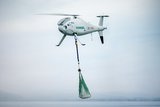US MDA prepares hypersonic and ballistic missile defence
The U.S. Navy conducted a static fire test in October 2021 of the newly developed common hypersonic missile. (Photo: US Navy)
Northrop Grumman has completed the critical design review of the Hypersonic and Ballistic Tracking Space Sensor (HBTSS) prototype for the US Missile Defense Agency.
The review establishes the company’s technical approach for precise timely sensor coverage to defeat ballistic and hypersonic missiles.
HBTSS satellites will provide continuous tracking and handoff to enable the targeting of enemy missiles.
They are an essential component of the Overhead Persistent Infrared multi-layered constellation of satellites, which can sense heat signatures to detect and track missiles from their earliest stages of launch.
The threat of hypersonic missiles has been a hot topic recently, following a Chinese missile test in August earlier this year.
A hypersonic glide vehicle (HGV) serves the same purpose as an intercontinental ballistic missile, but never leaves the atmosphere.
Instead, the HGV glides in the atmosphere and is able to perform skip glide manoeuvres which confuse missile defences, making it difficult to intercept and anticipate the target.
The US is now struggling to catch up in regards to hypersonic missile technology as China has now demonstrated their capability and Russia did so in 2019.
More from Air Warfare
-
![Norway receives final F-35 aircraft and unveils first Joint Strike Missile delivery]()
Norway receives final F-35 aircraft and unveils first Joint Strike Missile delivery
Work has begun on stockpiling the Joint Strike Missile (JSM), following the first missile’s delivery from Kongsberg and the Norwegian Defence Materiel Agency.
-
![US Air Force has big plans for the F-47]()
US Air Force has big plans for the F-47
The USAF Chief of Staff has claimed that the sixth-generation fighter would allow for guaranteeing “air superiority for generations to come”.
-
![India and France seal Rafale-M deal as plans for local assembly advance]()
India and France seal Rafale-M deal as plans for local assembly advance
Inter-governmental agreement signed as final assembly line plans inch closer.
-
![Just Released: New UAS Technology Report now available to read]()
Just Released: New UAS Technology Report now available to read
Autonomous advantage: Unlocking the potential of VTOL UAS in the battlefield resupply role
-
![Update: India’s Rafale-M deal postponed]()
Update: India’s Rafale-M deal postponed
New Delhi had been gearing up to sign a Navy Rafale deal as talks swirled around a potential assembly line in Nagpur.
-
![Turkey’s Eurofighter process going to plan despite German block, says minister]()
Turkey’s Eurofighter process going to plan despite German block, says minister
The comment, made by Turkish defence minister Yasar Guler, also noted that the 40-strong sale of Eurofighter Typhoons was primarily managed by the UK, not Germany.
























